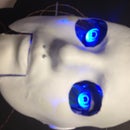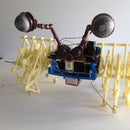Introduction: Simpler BARE Conductive Paint Paper Houses
Everything should be made is simple as possible, but not simpler. Albert Einstein
I saw the featured Bare Instructable on building paper houses with a painted circuit that lights the house up in the dark.
https://www.instructables.com/id/Making-a-Paper-House-that-lights-up-as-it-gets-dar/#intro
Christmas was a few days away, and I was thinking of making something for the two grandkids that we could work on together. They love art projects, and so decorating the finished houses seemed like a great idea.
I had bought a container of BARE conductive paint from Sparkfun with the idea of making interactive popup pages. I didn't have much luck in my initial tests, so I just shelved the project.
I checked out Sparkfun and the paper house kit is about $20; I thought I could whip something together myself.
I saw the featured Bare Instructable on building paper houses with a painted circuit that lights the house up in the dark.
https://www.instructables.com/id/Making-a-Paper-House-that-lights-up-as-it-gets-dar/#intro
Christmas was a few days away, and I was thinking of making something for the two grandkids that we could work on together. They love art projects, and so decorating the finished houses seemed like a great idea.
I had bought a container of BARE conductive paint from Sparkfun with the idea of making interactive popup pages. I didn't have much luck in my initial tests, so I just shelved the project.
I checked out Sparkfun and the paper house kit is about $20; I thought I could whip something together myself.
Step 1: Materials
I gathered up the components listed in the Bare Instructable. I had everything except for the specific transistor (BC548). However I had a stock of 2N3904 and 2N3906 transistors I use for robot switching circuits. I also thought that if was going to do an Instructable, the parts should be readily available from Radio Shack so that no one had to wait for an order to arrive.
I set up a breadboard with the components. Neither transistor worked with the circuit design given. After some fiddling around and experimenting, I came up with the circuit shown in the photo.
There are several variables which affect the circuit: the photoresistor you are using, the thickness of the paint, the leds you are using.
However, using a 10K trim pot seems to give a wide variance in adjusting the sensitivity correctly.
Here's my parts list:
10K-Ohm micro-size potentiometer #271-0282 $1.69
9V battery snap connectors(5) #270-0325 $3.69
Cadmium-Sulfide photocells(5) #276-1657 $2.99
2N3906 transistor (15) #276-1604 $2.99
LED - use 2 - Radio Shack sells various kinds
cardstock to print on
x-acto knife
metal ruler
a self-healing cutting board is nice
cardstock or paper that fits in your printer
ballpoint pen - a dead one works great to score the folds in the paper
snips or scissors to cut leads on parts
Tacky Glue or UHU stick glue
a small screwdriver to turn the micro potentiometer
waxed paper
masking tape
I have included the pdf designs on this page for download.
I set up a breadboard with the components. Neither transistor worked with the circuit design given. After some fiddling around and experimenting, I came up with the circuit shown in the photo.
There are several variables which affect the circuit: the photoresistor you are using, the thickness of the paint, the leds you are using.
However, using a 10K trim pot seems to give a wide variance in adjusting the sensitivity correctly.
Here's my parts list:
10K-Ohm micro-size potentiometer #271-0282 $1.69
9V battery snap connectors(5) #270-0325 $3.69
Cadmium-Sulfide photocells(5) #276-1657 $2.99
2N3906 transistor (15) #276-1604 $2.99
LED - use 2 - Radio Shack sells various kinds
cardstock to print on
x-acto knife
metal ruler
a self-healing cutting board is nice
cardstock or paper that fits in your printer
ballpoint pen - a dead one works great to score the folds in the paper
snips or scissors to cut leads on parts
Tacky Glue or UHU stick glue
a small screwdriver to turn the micro potentiometer
waxed paper
masking tape
I have included the pdf designs on this page for download.
Step 2: Print-cut-fold
Download the files below. You will need the two castle files to make a castle with an upper deck and the turret.
I like to use cardstock to print on. But you can really get creative by trying all sorts of paper with different levels of translucency. The structures are small enough that they should stand using even the thinnest paper.
Cut along the solid lines with scissors. I cut out the intricate parts with an x-acto knife.
Use a ballpoint pen and a ruler to score the lines. I try to keep one old pen that has no ink to use for this. But one with ink will work fine too. The ballpoint will compress the paper fibers and cause the paper or cardstock to neatly fold where you want it to.
I cut along three sides of the doors and cut out the windows at this point.
I fold each shape along the folding line several times to get a nice edge.
I like to use cardstock to print on. But you can really get creative by trying all sorts of paper with different levels of translucency. The structures are small enough that they should stand using even the thinnest paper.
Cut along the solid lines with scissors. I cut out the intricate parts with an x-acto knife.
Use a ballpoint pen and a ruler to score the lines. I try to keep one old pen that has no ink to use for this. But one with ink will work fine too. The ballpoint will compress the paper fibers and cause the paper or cardstock to neatly fold where you want it to.
I cut along three sides of the doors and cut out the windows at this point.
I fold each shape along the folding line several times to get a nice edge.
Step 3: Make the House
I redesigned the original house to give it a little more visual interest.
Glue the tab above the doorway to the dotted area on the roof piece. [See the first five photos] Use very little glue. Uhu stick is great, but for this project I am using Aleene's Tacky Glue because my Uhu stick dried out.
Use a fine, flat brush to paint in the Bare Conductive Paint along the grey lines. I added extra where the tab and the roof meet.
Take the photoresistor and bend the wires to conform to the painted lines. Leaving the leads long ensures that the resistor will stay put and it will have a good connection.
Strip some extra insulation from the battery wires. Having a longer wire will make the connection stronger and the electrical circuit more reliable with less resistance. I put masking tape on the wire because it is pretty stiff and I worried that taking the battery out and moving it about would break the connection.
Bend the right pin of the potentiometer up and out of the way. You could clip it completely off. The photo is of a 100K potentiometer, not a 10K but it worked just fine.
Bend the legs of the transistor to follow the painted lines. Again, this ensures a stronger physical connection as well as a good electrical one. Do the same with the LEDs making sure that the longer leg is attached to the positive line.
Use globs of paint to attach all of the components. Then wait overnight till the paint is completely dry.
Finally, glue the door wall to the end walls, the roof to the tabs, and the back wall to the side walls. I left the back roof unglued and added little bits of velcro so I can open the roof to change the battery.
Finally, I took a piece of waxed paper and folded it over. Then I attached pieces of masking tape and put the waxed paper over the LEDs like a tent. This diffuses the light and makes a nice soft inner illumination.
Decorate the outside with markers and you have a really cool light interactive house model.
Glue the tab above the doorway to the dotted area on the roof piece. [See the first five photos] Use very little glue. Uhu stick is great, but for this project I am using Aleene's Tacky Glue because my Uhu stick dried out.
Use a fine, flat brush to paint in the Bare Conductive Paint along the grey lines. I added extra where the tab and the roof meet.
Take the photoresistor and bend the wires to conform to the painted lines. Leaving the leads long ensures that the resistor will stay put and it will have a good connection.
Strip some extra insulation from the battery wires. Having a longer wire will make the connection stronger and the electrical circuit more reliable with less resistance. I put masking tape on the wire because it is pretty stiff and I worried that taking the battery out and moving it about would break the connection.
Bend the right pin of the potentiometer up and out of the way. You could clip it completely off. The photo is of a 100K potentiometer, not a 10K but it worked just fine.
Bend the legs of the transistor to follow the painted lines. Again, this ensures a stronger physical connection as well as a good electrical one. Do the same with the LEDs making sure that the longer leg is attached to the positive line.
Use globs of paint to attach all of the components. Then wait overnight till the paint is completely dry.
Finally, glue the door wall to the end walls, the roof to the tabs, and the back wall to the side walls. I left the back roof unglued and added little bits of velcro so I can open the roof to change the battery.
Finally, I took a piece of waxed paper and folded it over. Then I attached pieces of masking tape and put the waxed paper over the LEDs like a tent. This diffuses the light and makes a nice soft inner illumination.
Decorate the outside with markers and you have a really cool light interactive house model.
Step 4: Make the Castle
The castle pretty much follows the same procedures as for the house. Below you'll see how to assemble it. One hole in the roof is for the photoresistor. The other hole lets light into the upper turret.
I like to use clothespins and clips to hold pieces together to dry like you see in the photos of the turret pieces.
I glued the longer tabs to the turret cone and the shorter turret tabs to the floor of the roof.
You'll see that I attached the wax paper tent over the LEDs before I glued the side panels onto this one. I like the way it diffuses light.
This model opens itself to all sorts of customizing. You could add other turrets of different sizes to the top. Run a Google search for papercraft castles and you'll get all sorts of ideas.
I like to use clothespins and clips to hold pieces together to dry like you see in the photos of the turret pieces.
I glued the longer tabs to the turret cone and the shorter turret tabs to the floor of the roof.
You'll see that I attached the wax paper tent over the LEDs before I glued the side panels onto this one. I like the way it diffuses light.
This model opens itself to all sorts of customizing. You could add other turrets of different sizes to the top. Run a Google search for papercraft castles and you'll get all sorts of ideas.
Step 5: DONE?
Just as I thought I was finished with this project, I started getting other ideas. I dropped by the art store and bought some handmade paper with leaves in the pulp. It's very thin and the light makes a really nice warm glow along with the leaf patterns. I can imagine using various types of paper that could either go through the printer, or could be freehanded.
More Ideas: What about designing a Hobbit home? A fortress of solitude? A treehouse? The ideas are endless.
More Ideas: What about designing a Hobbit home? A fortress of solitude? A treehouse? The ideas are endless.






